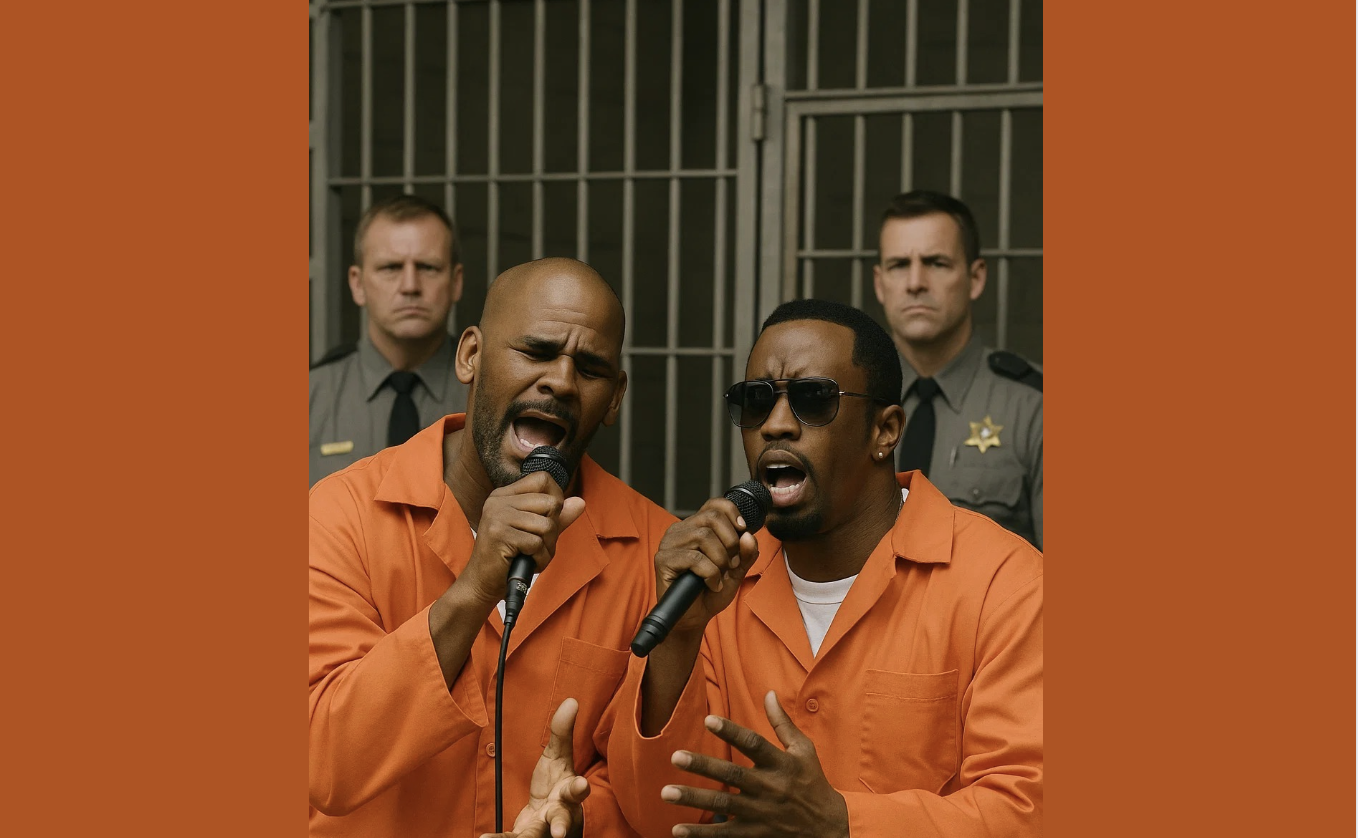On what began as a routine evening within the confines of a correctional facility, two major music legends, Diddy and R. Kelly, delivered an unexpected performance that reverberated far beyond the locked doors and barbed-wire fences. According to informed insiders, the two joined forces inside the prison, turning a normal night into a moment of unity, emotion and pure musical magic.
Witnesses at the prison say the atmosphere—typically heavy, quiet and tense—shifted the instant Diddy began tapping out a rhythm on a metal table in the cell block. The metallic beats echoed through the block, instantly capturing the attention of inmates and correctional officers alike. In that charged moment, R. Kelly’s unmistakeable voice rose, and the cell block transformed into an impromptu concert stage. The duo drew from a selection of old classics and gospel-inspired tunes, and even the guards paused their rounds to listen.

Sources describe the moment as “pure energy.” Some inmates were seen clapping, others wiping away tears, each lost in memories of being at a live concert—a feeling they had not experienced in years. For a few minutes, the walls, the pain, the noise all vanished. What remained was the music and the emotional connection it brought.
After the spontaneous set, Diddy reportedly told those around him, “Music heals everything—even here.” R. Kelly echoed the sentiment, saying that for a moment, he felt free again. The two embraced, shared laughter, and pledged to continue performing for their fellow inmates whenever possible. For those who witnessed it, the experience was far more than mere entertainment—it became a form of therapy, a fleeting escape from the harsh reality of incarceration.
Word of the performance quickly spread beyond prison walls, captivating fans around the world who reacted with a mix of shock, awe and admiration. On social media, users called it “a legendary moment in the unlikeliest place,” while others pointed out that it was a powerful reminder that talent, humanity and hope can survive the darkest places—even when the doors are locked, the lights are dimmed and the crowd is absent. No cameras captured it, no ticketed crowd filled the seats, yet two artists found light in darkness and shared it with those who needed it most.
What makes this story so compelling is how it illustrates the profound impact of music in unexpected circumstances. In a space defined by confinement, control and routine, the simple act of tapping a metal table and singing familiar songs broke the monotony and reminded everyone present of a more human experience. The inmates and guards alike found themselves transported, for a moment, into a different reality—a reality defined by rhythm, melody and shared emotion rather than bars, surveillance and time-served sentences.
The setting itself amplifies the significance of what occurred. A prison is typically a place of separation, of loss, of punishment. It is not where spontaneous creativity is expected to burst forth. Yet, in this environment, the two artists created a breathing, living moment—free of stage lights, microphones and fanfare—pure and raw. The fact that it emerged in such a setting only makes it stronger, more poignant. It challenges assumptions about where art can happen and who it is for.
This moment also underscores the non-commercial, deeply human side of performance. There was no audience in the traditional sense, no ticket sales, no cameras or flashbulbs—just a handful of people in an institutional space, entirely present with the music. In doing so, it served not just to entertain but to heal, to bridge divides and to momentarily dissolve invisible walls between people labeled as inmates and those labeled as visitors or guards. Music became a unifier.
For the inmates, especially, the effect was powerful. Many reported that the sound and the human connection brought back memories of freedom, of concerts past or hopes for the future. It reminded them that despite the uniformity of prison life and the absence of many freedoms, they were still human, still deserving of moments of joy, still capable of being moved. Some described it as a dreamlike pause in time—a brief moment where nothing else mattered but the harmony and the feeling it stirred.
For the guards and staff, too, the event seemed to carry weight. Witnesses say some stopped their routines, stood still and listened. In the midst of their responsibility to monitor and maintain order, they allowed themselves, however briefly, to be transported by the music. It created a shared human moment, transcending the usual roles of guard and inmate.
When news of the performance went public, reactions poured in. Many fans expressed awe that such a scene unfolded in a place where most days are defined by the absence of music and the absence of choice. Some commented that the event served as a reminder of the enduring nature of art, of how creativity cannot be completely contained—even by prison walls. Others noted how the story stands as evidence of the potential for moments of light in the darkest settings.
It is worth reflecting on the wider implications of this event. Art and music have long been documented as tools of comfort, resistance and transformation. In this case, they provided a reprieve from confinement, a reminder of connection and a platform for human expression. The fact that two high-profile artists chose to engage directly, within that context, adds a layer of symbolism—one of solidarity, one of humanity, one of presence.
Even more, in a world where performance is often synonymous with spectacle, production and profit, this unscripted moment emphasizes the opposite: intimacy, spontaneity and authenticity. It took place without preparation, without lights or sound checks, and yet it delivered a deeply felt experience. That in itself is a powerful reminder of what music is at its core—communication, emotion, shared presence—not always performance for profit or acclaim.
In conclusion, what unfolded inside that cell block was more than a footnote or a quirky anecdote—it was a rare demonstration of how music can transcend environment, labels and expectation. In a place defined by limitation, two artists created freedom—if only for a few minutes. Their act resonated with inmates, guards and eventually the wider world, shining a light on how creativity and humanity persist even behind locked doors. It reminds us all that no matter where we are—or what our circumstances—music can still offer hope, connection and healing.





